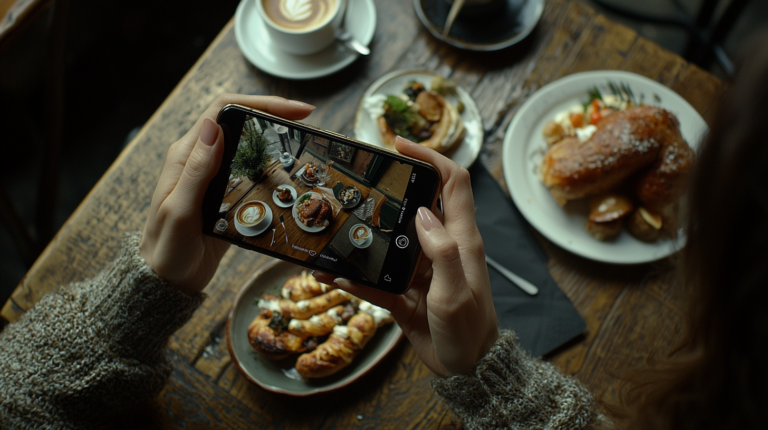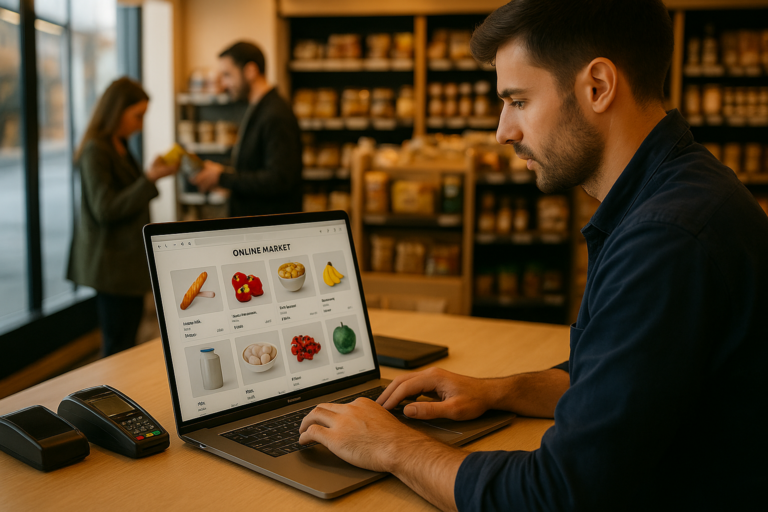Retail marketing: tips, tricks and more

With more than 1 million brick-and-mortar stores in the US alone and innumerable storefronts cropping up online – standing out from the crowd isn’t just for retailers.1 It can make or break any business.
As consumers (and modern-day humans) we know instinctively that even the highest quality products will struggle to find buyers if no one knows they exist. That makes an expertly honed retail marketing plan the golden ticket to rising above the noise: it’s how brands reach customers, make an impression and build an enduring relationship.
Even so, the marketing tactics that work for digital-only brands won’t necessarily propel retailers forward. This is where a marketing retail strategy should be considered.
So how can businesses create a retail marketing campaign and reach a potential customer or increase brand awareness? Rather than burning margins and throwing strategies at the wall to see what sticks, let’s start with the essentials: 6 concrete approaches retailers can use to build the bones of their marketing plan.
What makes retail marketing unique?
Despite its complexity in practice, there’s one thing that’s straightforward about digital marketing: virtually all of its cornerstone communication channels are online.
Retail marketing isn’t as clear-cut. Advancing a brick-and-mortar store can touch upon nearly every aspect of a business, from the posts a brand makes on social media to the team it employs on the floor.
The classic advertising “Four P” marketing mix (Product, Price, Place and Promotion) have been part of a solid retail marketing strategy since the mid-20th century.2 These days, however, retail businesses need to be integrating two additional factors:
- People – The people involved in a retail business’s operation are a crucial part of the consumer experience. Retail marketing focuses on improving this. “People” runs the gamut from customer service representatives to the affiliates and creators brands partner with on social media.
- Presentation – Presentation refers to all facets of how a retail business presents itself to existing and potential customers. It encompasses everything from the bags at check-out to online presence.
With the basics under our belts, let’s dive into 7 ways businesses can hone their retail marketing strategy.
And yes—we mean digitally and IRL.
#1 Try out SMS marketing
Most consumers call it texting, but most marketers call it SMS—whatever the name, this marketing channel has a 98% open rate.3
Retailers who haven’t complemented their email marketing strategy with SMS could be missing out on new ways to reach and enhance their customer base. Similar to email marketing, SMS marketing is particularly good for:4
- Notifying customers about promotions – Retailers ranging from Ogee to SIO use SMS to inform prospective buyers about flash sales, promotions and other special events. Texts are ideal for motivating customers to act in the moment.
- Sending important updates – Brands from Airbnb to Michaels use SMS to make customer service more efficient by issuing updates, swift responses and notifications. Not only can updates urge customers to move forward with pending purchases, but they can add more value to their existing ones.
But SMS isn’t just for spreading the word about an upcoming sale or encouraging a consumer to reconsider an abandoned shopping cart.
Brands can also use it to enhance customer experience such as:
- Offer consumers personal recommendations
- Thank customers for their business
- Provide them with gift guides over the holidays
- Assist them with questions they might have about the product
So, how can businesses incentivize a new or even existing customer to register their number with their SMS list? One of the biggest draws is offering them a certain percentage off their purchase for signing up. Alternatively, offer customers a free product in exchange for their digits.
#2 Build a loyalty program
Everyone from Target to the local coffee shop has a loyalty program (and thank goodness for those “buy 10 lattes, get one free” punch cards).
For businesses that don’t have a loyalty program yet, here are two reasons to set one up:5
- 79% of consumers report they would be more inclined to return to a business that offers a loyalty program
- 73% of consumers say they’d recommend a brand whose loyalty program rewards its customers
In other words, loyalty programs are critical for bolstering customer retention and acquisition. (Chances are that many brands probably already have loyal customers that keep coming back.) It’s one of the best ways to achieve security as a brick-and-mortar company, as retaining customers is typically more cost-effective than netting new ones.
#3 Offer product samples
Brands should consider offering samples as part of retail marketing efforts within a physical store. Even before inflation gave us a reason to think twice before breaking out our wallets, consumers loved testing out products before committing to them.
And the data doesn’t lie. 61% of consumers say they’d like to try out a product before making a purchase decision.1
This marketing strategy may even be more accessible to brick-and-mortar stores than their online competitors. Whether that means giving their clients a taste of mini lemon compote, manufacturing a limited batch of travel-sized scented candles, or tucking a gift-wrapped token of gratitude in with their purchase – brands should never underestimate the power of “free” to let customers know they care.
#4 Increase visibility with local SEO
Even businesses that are strictly online retailers may benefit from using local SEO best practices.
Here’s why:
- It may improve the brand’s rankings and amplify their online presence.
- It capitalizes on the “shop local” trend.
- It might boost relevant web traffic.
- It helps them build a reputation in their community.
- It could increase foot traffic (for brick-and-mortar stores).
Brands that don’t have an SEO dream team on hand should consider partnering with a digital marketing agency that offers local-friendly SEO to drive up their foot traffic.
#5 Express values
The sheer size and competitiveness of the retail space can feel daunting to both established and emerging retailers—but for consumers, it’s a gift.
Why? Because they get to be more discerning about who they buy from.
Cause marketing and value-based consumption habits have been on the incline for years now, and many analysts argue the COVID-19 era accelerated the trend.6 Today’s consumers—particularly millennials, Gen Z and Gen Alpha—don’t just want a quality product at a fair price. They want a company that possesses values we admire or that mirror their own.6
Here’s how this has historically looked in a retail marketing:
- Dove’s “Real Beauty” campaign – A classic case study, this was one of the most successful retail marketing campaigns since the early 2000s. Featuring models that represented versatile body types, Dove overhauled in-store displays, print ads and more to advocate for body positivity.
And their efforts paid off: the campaign reached a slew of new consumers, leading to a 700% boost in sales in the campaign’s first six months.7
- Patagonia’s “Footprint Chronicles” – From supply chain concerns to hidden toxins, consumers increasingly scrutinize the products they buy and consume. Brands can work this to their advantage by being transparent about their products and processes. Patagonia nailed this (and rocked the retail world) with their “Footprint Chronicles”. As of 2022, Time has named them one of the planet’s 100 most influential companies.8
Ultimately, the Corporate Social Responsibility (CSR) values should be authentic to each business and team.9 The point here is to use collective status to put some muscle behind them and to forge bonds with a specific set of consumers who share the brand’s values.
And whatever impact a business makes, they’ll want to be sure to share it with their customers. This gives customers a chance to take action by supporting the brand.
#6 Leverage content marketing
Some businesses may think that their product speaks for itself—and they might be right. But for retailers, it’s crucial to focus on growth by asking what a single purchase could lead to next.
In other words, where does the business’ target consumer want to go? And what do they need to learn to get there?
That’s where SEO and content marketing come in. An informative, engaging blog post that creates more value for a user may lead to a sale: 34% of consumers have gone through with an unplanned purchase after reading an article that resonated with them.10
Whether a brand sells vintage shoes or water filters, there is always something they can teach consumers that will:
- Meaningfully (or measurably) enhance their lives
- Add dimension to their experience of the product
- Build on their relationship with the brand
Brands can use content marketing to discuss anything—emerging trends in their industry, a cause the business cares about, or an idea that could make them a thought leader in their sector. Whatever it is, a brand’s content should give back to the customer while giving them something to come back for. The benefits of content marketing go beyond just writing blogs—it’s a great way to leverage a brand’s assets while being informative.
Build more with your retail marketing strategy with Power Digital
There are 1.8 million online retailers across the nation.1 The difference between “a here today, gone tomorrow” retailer and one that endures comes down to one thing: Brand integrity, across IRL and digital channels alike.
The takeaway? For businesses that have been hyper-focused on their product at the expense of their presence, now is the time to reassess and polish.
We built Power Digital to be a tech-enabled growth firm that can help your business take that next step. Our suite of marketing services—including content marketing, SEO, affiliate marketing, social media and more—all aim to help retailers and their online counterparts to expand brand awareness, strengthen credibility and spark revenue.
Get started by requesting a proposal from us today.
Sources:
- Zippia. 21 compelling retail statistics (2022): how many retailers are in the US. https://www.zippia.com/advice/retail-statistics/
- Investopedia. The 4 Ps of Marketing and How to Use Them in Your Strategy. https://www.investopedia.com/terms/f/four-ps.asp
- Forbes. Five Tips For Leveraging SMS Marketing In 2022. https://www.forbes.com/sites/forbescommunicationscouncil/2022/05/31/five-tips-for-leveraging-sms-marketing-in-2022/?sh=2a4b11be27cc
- SMS Comparison. Text messaging statistics 2022–SMS trends for businesses. https://www.smscomparison.com/mass-text-messaging/2022-statistics/
- Forbes. 50 stats that show the importance of a good loyalty program even during a crisis. https://www.forbes.com/sites/blakemorgan/2020/05/07/50-stats-that-show-the-importance-of-good-loyalty-programs-even-during-a-crisis/?sh=15686e3c2410
- Forbes. How Social Values Drive Consumers To Brands. https://www.forbes.com/sites/jiawertz/2021/12/27/how-social-values-drive-consumers-to-brands/?sh=78cadbaa7425
- PR Week. When Dove got real: the history of a brand turnaround.https://www.prweek.com/article/1351936/when-dove-real-history-brand-turnaround
- Time. Patagonia is one of the 2022 Time 100 most influential companies. https://time.com/collection/time100-companies-2022/6159439/patagonia/
- Indeed. What is cause marketing/ Definition and how to build a campaign. https://www.indeed.com/career-advice/career-development/what-is-cause-marketing
- SEM Rush. 81 of the most up-to-date blogging statistics in 2021. https://www.semrush.com/blog/blogging-stats/
- Oberlo. 10 branding statistics you need to know in 2022. https://www.oberlo.com/blog/branding-statistics
Our Editorial Standards
Reviewed for Accuracy
Every piece is fact-checked for precision.
Up-to-Date Research
We reflect the latest trends and insights.
Credible References
Backed by trusted industry sources.
Actionable & Insight-Driven
Strategic takeaways for real results.


















